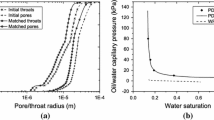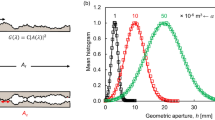Abstract
We use pore scale network modeling to study the effects of flow rate and contact angle on imbibition relative permeabilities. The model accounts for flow in wetting layers that occupy roughness or crevices in the pore space. Viscous forces are accounted for by solving for the wetting phase pressure and assuming a fixed conductance in wetting layers. Three-dimensional simulations model granular media, whereas two-dimensional runs represent fracture flow.
We identify five generic types of displacement pattern as we vary capillary number, contact angle, and initial wetting phase saturation: flat frontal advance, dendritic frontal advance, bond percolation, compact cluster growth, and ramified cluster growth. Using phase diagrams we quantify the range of physical properties under which each regime is observed. The work explains apparently inconsistent experimental measurements of relative permeability in granular media and fractures.
Similar content being viewed by others
References
Billiotte, J., De Moegen, H. and Øren, P. E.: 1993, Experimental micro-modeling and numerical simulation of gas/water injection/withdrawl cycles as applied to underground gas storage reservoir, SPE Adv. Technol. Series 1(1), 133–139.
Blunt, M. and King, P.: 1991, Relative permeabilities from two-and three-dimensional pore-scale network modelling, Transport in Porous Media 6, 407–433.
Blunt, M., King, M. J. and Scher, H.: 1992, Simulation and theory of two-phase flow in porous media, Phys. Rev. A 46(12), 7680–7699.
Blunt, M. J.: 1997, Effects of heterogeneity and wetting on relative permeability using pore level modeling, SPE J. 2, 70–87.
Blunt, M. J. and Scher, H.: 1995, Pore-level modeling of wetting, Phys. Rev. E 52, 6387–6403.
Bryant, S. and Blunt, M.: 1992, Prediction of relative permeability in simple porous media, Phys. Rev. A 46, 2004–2011.
Chaouche, M., Rakotomalala, N., Salin, D., Xu, B. and Yortsos, Y. C.: 1993, Capillary effects in heterogeneous porous media: experiments, pore network simulations and continuum modeling, Paper SPE 26658, Proc. 68th SPE Annual Technical Conference and Exhibition, Houston, TX.
Constantinides, G. N. and Payatakes, A. C.: 1996, Network simulation of steady-state two-phase flow in consolidated porous media, AIChE J. 42, 369–382.
Dias, M. M. and Payatakes, A. C.: 1986a, Network models for two-phase flow in porous media: 1. Immiscibe microdisplacement of nonwetting fluids, J. Fluid Mech. 164, 305–336.
Dias, M. M. and Payatakes, A. C.: 1986b, Network models for two-phase flow in porous media: 2. Motion of oil ganglia, J. Fluid Mech. 164, 337–358.
Dullien, F. A. L.: 1992, Porous Media: Fluid Transport and Pore Structure, 2nd edn, Academic Press, San Diego.
Fenwick, D. H. and Blunt, M. J.: 1998, Three-dimensional modeling of three phase imbibition and drainage, Adv. Water Resour. 21(2), 121–143.
Fourar, M., Bories, S., Lenormand, R. and Persoff, P.: 1993, Two-phase flow in smooth and rough fractures: measurement and correlation by porous-medium and pipe flow models, Water Resour. Res. 29(4), 775–794.
Glass, R. J., Nicholl, M. J. and Yarrington, L.: 1998, A modified invasion percolation model for low-capillary number immiscible displacements in horizontal rough-walled fractures: influence of local in-plane curvature, Water Resour. Res. 34(12), 3215–3234.
Haghighi, M.: 1994, Visualization and simulation of immiscible displacement in fractured systems using micromodels: drainage, imbibition and steam injection, PhD Thesis, University of Southern California, Los Angeles, CA.
Heiba, A. A., Sahimi, M., Scriven, L. E. and Davis, H. T.: 1992, Percolation theory of two-phase relative permeability, SPE Reservoir Engng 7, 123–132.
Hughes, R. G. and Blunt, M. J.: 1999, Pore-scale modeling of multiphase flow in fractures and matrix/fracture transfer, Paper SPE 56411, Proc. 74th SPE Annual Technical Conference and Exhibition, Houston, TX.
Jerauld, G. R. and Salter, S. J.: 1990, The effect of pore-structure on hysteresis in relative permeabilty and capillary pressure: pore-level modeling, Transport in Porous Media 5, 103–151.
Ji, H. and Robbins, M. O.: 1992, Percolative, self-affine and faceted domain growth in random threedimensional magnets, Phys. Rev. B 46, 14519–14527.
Koiller, B., Ji, H. and Robbins, M. O.: 1992, Fluid wetting properties and the invasion of square networks, Phys. Rev. B 45, 7762–7767.
Koplick, J. and Lasseter, T. J.: 1985, Two-phase flow in random network models of porous media, SPE J. 25, 89–100.
Lake, L. W.: 1989, Enhanced Oil Recovery, Prentice Hall Inc, Englewood Cliffs, NJ.
Lee, S. H., Padmanabhan, L. and Al-Sunaidi, H. A.: 1996, Simulation of linear displacement experiments on massively parallel computers, SPE J. 1, 327–340.
Lenormand, R. and Zarcone, C.: 1984a, Growth of clusters during imbibition in a network of capillaries, In: F. Family and D. P. Landau (eds), Kinetics of Aggregation and Gellation, Elsevier Science Publishers, Amsterdam, Netherlands, pp. 177–180.
Lenormand, R. and Zarcone, C.: 1984b, Role of roughness and edges during imbibition in square capillaries, Paper SPE 13264, Proc. 59th SPE Annual Technical Conference and Exhibition, Houston, TX.
Lenormand, R., Touboul, E. and Zarcone, C.: 1988, Numerical models and experiments on immiscible displacements in porous media, J. Fluid Mech. 189, 165–187.
Lenormand, R., Zarcone, C. and Sarr, A.: 1983, Mechanisms of the displacement of one fluid by another in a network of capillary ducts, J. Fluid Mech. 135, 337–353.
Ma, S., Mason, G. and Morrow, N. R.: 1996, Effect of contact angle on drainage and imbibition in regular polygonal tubes, Colloids and Surfaces A 117, 273–291.
Mani, V. and Mohanty, K. K.: 1997, Pore-level network modeling of three-phase capillary pressure and relative permeability curves, Paper SPE 38883, Proc. 72nd Annual Technical Conference and Exhibition of the SPE, San Antonio, TX.
McDougall, S. R. and Sorbie, K. S.: 1995, The impact of wettability on waterflooding: pore-scale simulation, SPE Reservoir Engng 10, 208–213.
Merrill, L. S., Jr.: 1975, Two phase flow in fractures, PhD Thesis, University of Denver, Denver, CO.
Mogensen, K. and Stenby, E.: 1998, A dynamic pore-scale model of imbibition, paper SPE 39658, Proc. Improved Oil Recovery Symposium, Tulsa, OK.
Mohanty, K. K., Davis, H. T. and Scriven, L. E.: 1987, Physics of oil entrapment in water-wet rock, SPE Reservoir Engng 2(1), 113–128.
Morrow, N. R., Chatzis, I. and Tabor, J. J.: 1988, Entrapment and mobilization of residual oil in bead packs, SPE Reservoir Engng 3, 927–934.
Øren, P. E. and Pinczewski, W. V.: 1995, Fluid distribution and pore-scale displacement mechanisms in drainage dominated three-phase flow, Transport in Porous Media 20(1-2), 105–133.
Pereira, G. G., Pinczewski, W. V., Chan, D. Y. C., Paterson, L. and Øren, P. E.: 1996, Pore-scale network model for drainage dominated three-phase flow in porous media, Transport in Porous Media 24(2), 157–166.
Pruess, K. and Tsang, Y. W.: 1990, On two-phase relative permeability and capillary pressure of rough-walled rock fractures, Water Resour. Res. 26(9), 1915–1926.
Ransohoff, T. C. and Radke, C. J.: 1988, Laminar flow of a wetting liquid along the corners of a predominantly gas-occupied noncircular pore, J. Colloid Interface Sci. 121, 392–401.
Romm, E. S.: 1966, Fluid Flow in Fractured Rocks, “Nedra” Publishing House, Moscow (translated from Russian).
Rossen, W. R. and Kumar, A. T. A.: 1992, Single-and two-phase flow in natural fractures, Paper SPE 24915, Proc. 67th SPE Annual Technical Conference and Exhibition, Washington D.C.
Weibull, W.: 1951, A Statistical distribution function of wide applicability, J. Appl. Mech. 18, 293–297.
Wilkinson, D. and Willemsen, J. F.: 1983, Invasion percolation: a new form of percolation theory, J. Phys. A 16, 3365–3376.
Zhou, D. and Orr, F. M., Jr.: 1995, The effects of gravity and viscous forces on residual nonwettingphase saturation, In Situ 19, 249–273.
Zhou, D., Blunt, M. J. and Orr, F. M., Jr.: 1997, Hydrocarbon drainage along corners of noncircular capillaries, J. Colloid Interface Sci. 187, 11–21.
Author information
Authors and Affiliations
Rights and permissions
About this article
Cite this article
Hughes, R.G., Blunt, M.J. Pore Scale Modeling of Rate Effects in Imbibition. Transport in Porous Media 40, 295–322 (2000). https://doi.org/10.1023/A:1006629019153
Issue Date:
DOI: https://doi.org/10.1023/A:1006629019153




